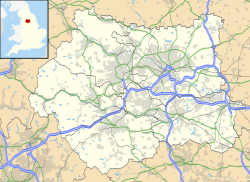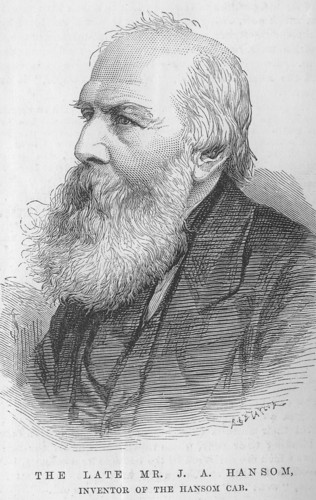
Joseph Aloysius Hansom was a British architect working principally in the Gothic Revival style. He invented the Hansom cab and founded the eminent architectural journal The Builder in 1843.

St Walburge's Church is a Roman Catholic church in Preston, Lancashire, England, northwest of the city centre on Weston Street. The church was built in the mid-19th century to a design by the Gothic Revival architect Joseph Hansom, the designer of the hansom cab, and is famous as having the tallest spire of any parish church in England. St Walburge's is recorded in the National Heritage List for England as a Grade I listed building.
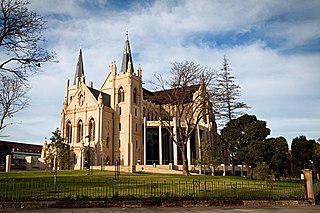
St Mary's Cathedral, Perth, officially the Cathedral of the Immaculate Conception of the Blessed Virgin Mary, is the cathedral church of the Roman Catholic Archdiocese of Perth and seat of its archbishop, currently Timothy Costelloe.

Leeds Cathedral, formally the Cathedral Church of St Anne, also known as Saint Anne's Cathedral, is the cathedral of the Roman Catholic Diocese of Leeds, and is the seat of the Roman Catholic Bishop of Leeds. It is in the city of Leeds, West Yorkshire, United Kingdom. The city of Leeds does not have a Church of England cathedral although it is in the Anglican Diocese of Leeds. The cathedrals of the Anglican diocese are in Ripon, Wakefield and Bradford. The city instead has a Minster which is similar to nearby Dewsbury Minster and Halifax Minster, all of which are parish churches.
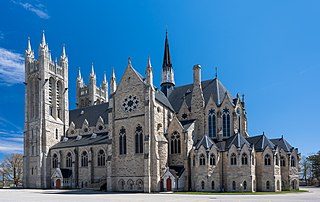
Basilica of Our Lady of the Immaculate Conception is a Roman Catholic minor basilica and parish church in Guelph, Ontario, Canada. A Gothic Revival style building constructed between 1876 and 1888 by architect Joseph Connolly, it is considered Connolly's best work. The monumental church contains decorative carving and stained glass executed by skilled craftsmen. The church of Our Lady is one of the 122 parishes in the Diocese of Hamilton and currently has 2,600 families in the congregation.

Basilica of St Patrick is a Roman Catholic church located on Adelaide Street in Fremantle, Western Australia. It is one of five churches in Australia with minor basilica status.

St. Aloysius of Gonzaga Church is a Roman Catholic church in Nashua, New Hampshire, United States. The church is part of the Roman Catholic Diocese of Manchester, New Hampshire.
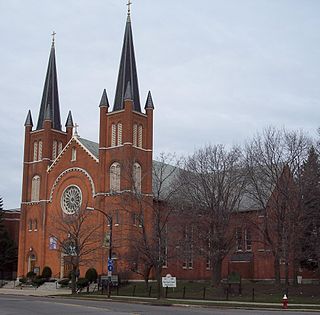
Holy Angels Church is located in the lower west side of Buffalo, New York, adjacent to D'Youville College. The parish has been served by the Oblates of Mary Immaculate from 1851-2020. In October 2020, D'Youville College purchased the Holy Angels Church, Rectory, and Convent.

St Thomas Church is a historic Roman Catholic church in St. Helier, Jersey. It is the largest church in the Channel Islands, and first opened its doors in 1887.
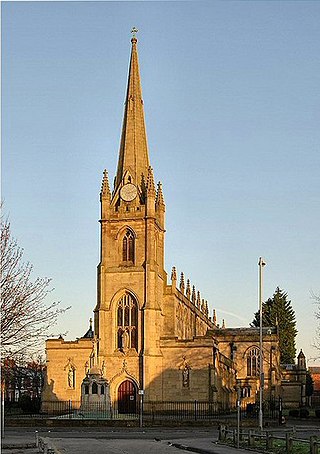
The Syro-Malabar Cathedral of St Alphonsa is a Catholic cathedral of the Syro-Malabar rite in Preston, Lancashire. It is the cathedral of the Syro-Malabar Catholic Eparchy of Great Britain, and was previously St Ignatius Church under the Diocese of Lancaster. It is situated close to the Preston city centre, with the entrance on Meadow Street. The building was opened in 1836 and was the first church in Preston to have a spire.

English Martyrs Church or its full name The Church of St Thomas of Canterbury and the English Martyrs is a Roman Catholic Parish church in Preston, Lancashire. It was designed by Edward Welby Pugin and is a shrine church of the Diocese of Lancaster within the Parish of St John XXIII, Preston. It is near to Preston city centre and stands on the corner of the A6, between Aqueduct Street and St George's Road.

The second St Mary's Roman Catholic Church is a heritage-listed sandstone Catholic church at 163 Palmerin Street in Warwick in the Southern Downs Region, Queensland, Australia. It was designed by Dornbusch & Connolly and built from 1920 to 1926. It is also known as St Mary of the Assumption Church. It was added to the Queensland Heritage Register on 21 October 1992.
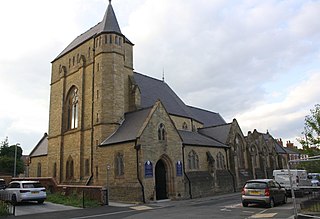
Annunciation Church is a Roman Catholic Parish church in Chesterfield, Derbyshire. It was founded by the Society of Jesus in 1854. Located in Spencer Street, near Saltergate and off-Newbold Road, it was designed by the architect Joseph Hansom and is a Grade II listed building.

St. Mary's Church, Presbytery and Convent are in Back Lane, Little Crosby, Sefton, Merseyside, England. The church is an active Roman Catholic parish church in the diocese of Liverpool which was built in 1845–47. The presbytery and convent were both built in the 18th century, and altered in the 19th century. The convent originated as a chapel, and has since been converted into a private dwelling. Both the church and the former convent with its attached presbytery are recorded in the National Heritage List for England as designated Grade II listed buildings.

St Mary's Church is a heritage-listed Roman Catholic church at 20 Merivale Street, South Brisbane, Queensland, Australia. It was designed by Simkin and Ibler and built from 1892 to 1929. It was added to the Queensland Heritage Register on 3 December 2004.

The Church of St Mary of the Assumption is in Yorkshire Street, Burnley, Lancashire, England. It is an active Roman Catholic parish church in the diocese of Salford. The church is recorded in the National Heritage List for England as a designated Grade II listed building. It was built between 1846 and 1849 to replace a smaller chapel on a different site. The church was designed by Weightman and Hadfield in Decorated style, and a chapel was added to it in 1879.

St Mary Star of the Sea (Leith) Church is a Roman Catholic parish church in Edinburgh, Scotland. It is situated on Constitution Street in the Leith district and staffed by the Missionary Oblates of Mary Immaculate.

Cathedral of St Michael and St John is a heritage-listed Roman Catholic cathedral at 107 William Street, Bathurst, Bathurst Region, New South Wales, Australia. It was designed by Charles Hansom and built from 1857 to 1861 by Edward Gell. It is also known as Cathedral of Saints Michael and John. The cathedral is the episcopal see of the Roman Catholic Bishop of Bathurst. The property is owned by the Roman Catholic Diocese of Bathurst. It was added to the New South Wales State Heritage Register on 5 June 2012.

Sacred Heart Church or the Church of the Sacred Heart of Jesus is a Roman Catholic parish church in Kilburn, London. It was designed by E. W. Pugin and built after his death by his brothers Pugin & Pugin in two stages, in 1879 and from 1898 to 1899. It is located on the corner Quex Road and Mazenod Road, next to St Eugene de Mazenod Primary School. It was founded by the Missionary Oblates of Mary Immaculate who continue to serve the parish.

St Mary's Church or St Mary Immaculate Church is a Roman Catholic parish church in Falmouth, Cornwall, England, United Kingdom. It was built from 1868 to 1869 and designed by Joseph Hansom. The architecture of the church, according to Historic England is a blend of "Gothic and Burgundian Romanesque styles". It is located on the corner of Kimberley Place and Killigrew Street. It was extended by Hansom's son Joseph Stanislaus Hansom in 1881 and it is a Grade II listed building.

